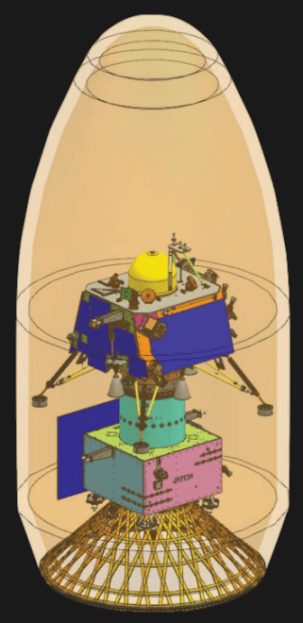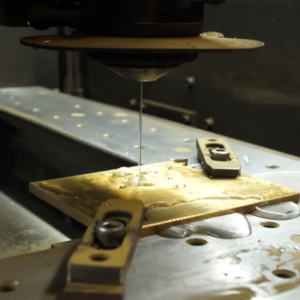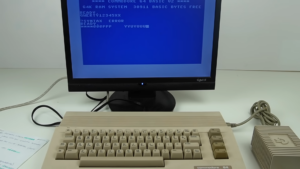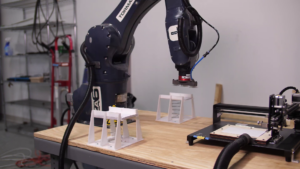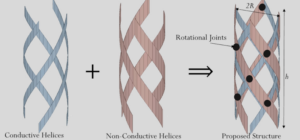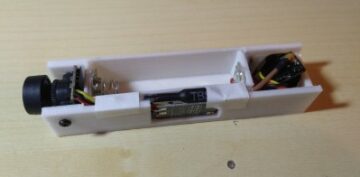Yesterday, the Indian Space Research Organization’s (ISRO) Chandrayaan-3 spacecraft performed a powered soft-landing on the Moon, officially making India the fourth country to achieve a controlled descent to the lunar surface. Up to this point, only the United States, China, and the Soviet Union could boast successful landings on our nearest celestial neighbor.
Chandrayaan-3 Packed for Launch
” data-medium-file=”https://platoaistream.com/wp-content/uploads/2023/08/india-makes-history-with-chandrayaan-3-landing-3.png?w=195″ data-large-file=”https://platoaistream.com/wp-content/uploads/2023/08/india-makes-history-with-chandrayaan-3-landing.png” decoding=”async” class=” wp-image-610614″ src=”https://platoaistream.com/wp-content/uploads/2023/08/india-makes-history-with-chandrayaan-3-landing.png” alt width=”230″ height=”473″ srcset=”https://platoaistream.com/wp-content/uploads/2023/08/india-makes-history-with-chandrayaan-3-landing-3.png 336w, https://platoaistream.com/wp-content/uploads/2023/08/india-makes-history-with-chandrayaan-3-landing-3.png?resize=122,250 122w, https://platoaistream.com/wp-content/uploads/2023/08/india-makes-history-with-chandrayaan-3-landing-3.png?resize=195,400 195w, https://platoaistream.com/wp-content/uploads/2023/08/india-makes-history-with-chandrayaan-3-landing-3.png?resize=304,625 304w” sizes=”(max-width: 230px) 100vw, 230px”>
What’s more, Chandrayaan-3 has positioned itself closer to the Moon’s south pole than any other mission in history. This area is of great interest to scientists, as there is evidence that deep craters in the polar region contain considerable deposits of frozen water. At the same time, the polar highlands receive almost constant sunlight, making it the perfect location to install solar arrays. These factors make the Moon’s south pole an ideal candidate for a future human outpost, and Chandrayaan-3 is just one of several robotic craft that will explore this area in the coming years.
But as is usually the case with space exploration, the success of Chandrayaan-3 didn’t come easy, or quickly. The ISRO started the Chandrayaan program in 2003, and launched the Chandrayaan-1 mission in 2008. The craft successfully entered lunar orbit and surveyed the surface using a wide array of instruments, many of which were provided by foreign space agencies such as NASA and the ESA. In 2019 the far more ambitious Chandrayaan-2 mission was launched, which included a lander and small rover. While the orbiter component of Chandrayaan-2 was a complete success, the lander crashed into the Moon’s surface and was destroyed.
With Chandrayaan-3 now safely on the surface of the Moon, there’s much work to be done in the coming days. The planned mission lifetime for both the lander and rover is a single lunar day, which equals just about two weeks here on Earth. After that, the vehicles will be plunged into a long stretch of frigid darkness which they likely won’t survive.
Lander Lessons
The lander component of Chandrayaan-3, known as Vikram, measures approximately 2 meters (6.5 feet) on each side and has a total mass of 1749.86 kilograms (3857 pounds). The design is very similar to that of its 2019 predecessor, but ISRO made several modifications to improve not only the reliability and accuracy of the onboard systems, but the structural strength of the lander itself.
 One of the most obvious changes is the arrangement of its rocket engines. On Chandrayaan-2, the lander had one central fixed-thrust engine, and four variable thrust engines on the periphery with vectoring capability. The idea was that the center engine would do most of the work to slow the craft down, while the outer engines would provide attitude control. Unfortunately, this arrangement proved sluggish during the previous landing attempt.
One of the most obvious changes is the arrangement of its rocket engines. On Chandrayaan-2, the lander had one central fixed-thrust engine, and four variable thrust engines on the periphery with vectoring capability. The idea was that the center engine would do most of the work to slow the craft down, while the outer engines would provide attitude control. Unfortunately, this arrangement proved sluggish during the previous landing attempt.
For Chandrayaan-3, ISRO engineers removed the central rocket engine and improved the vectoring ability of the four outer engines. This allowed the new lander to more rapidly adjust its attitude in the final moments before touchdown. The new lander also featured an upgraded Laser Doppler Velocimeter (LDV) that was able to provide more accurate positional data during descent.
While the lander’s primary function is arguably to deliver the mission’s rover, it does feature onboard scientific payloads of its own. This includes Chandra’s Surface Thermophysical Experiment (ChaSTE), which will study the temperature of the lunar surface, the Instrument for Lunar Seismic Activity (ILSA) which aims to detect quakes within the Moon’s interior, and the Langmuir Probe (LP) to measure near-surface plasma density.
Rover Do-Over
While the crash of Chandrayaan-2 resulted in modifications being made to the lander, there was no reason to believe the mission’s rover wouldn’t have worked as expected if it had been deployed. As such, the six-wheeled Pragyan rover on Chandrayaan-3 is identical to its predecessor, down to the same scientific payloads.
 Outwardly similar to NASA’s Sojourner Mars rover, Pragyan has a mass of 26 kg (57 lbs) and measures roughly 92 cm (3 feet) by 75 cm (2.4 feet). It features stereoscopic vision thanks to a pair of one megapixel monochromatic NAVCAMs mounted on the front of the vehicle, which provides ground controllers with a digital elevation model of the terrain ahead.
Outwardly similar to NASA’s Sojourner Mars rover, Pragyan has a mass of 26 kg (57 lbs) and measures roughly 92 cm (3 feet) by 75 cm (2.4 feet). It features stereoscopic vision thanks to a pair of one megapixel monochromatic NAVCAMs mounted on the front of the vehicle, which provides ground controllers with a digital elevation model of the terrain ahead.
Each of the six wheels that make up the rocker-bogie suspension system has its own independent brushless DC motor for redundancy, and can propel the rover at a rate of one centimeter per second. Since the rover uses the lander as a communication relay, it’s expected to remain within a 500 meter (1640 feet) radius of the landing site for the duration of its mission.
In terms of science hardware, the rover is carrying a Laser Induced Breakdown Spectroscope (LIBS) and the Alpha Particle Induced X-ray Spectroscope (APXS). Both devices will be used to determine the elemental composition of the lunar soil and any rocks the rover encounters. While it’s hoped that Pragyan will be able to find and directly examine frozen water on the lunar surface, there’s obviously an element of chance involved, especially given the mission’s relatively brief operational period. As such, the mission will achieve its scientific goals even if it doesn’t encounter any ice.
One Small Step
Over the next two weeks, we should expect a flurry of images from the ISRO as Pragyan explores the landing site. And we’ll see twice as many if the rover manages to identify frozen water. With Chandrayaan-3, India has demonstrated to the world that they’ve become a major player in space, a victory that’s all the more impressive just days after Russia’s failed attempt at putting their own lander on the Moon.
But this isn’t the end of India’s lunar ambitions. Planning is already underway for Chandrayaan-4, which will be a joint mission with Japan’s Aerospace Exploration Agency (JAXA) launching sometime between 2026 and 2028. The mission will utilize a larger lander that’s capable of bringing at least 350 kg (770 lb) of hardware to the lunar surface, and a rover that features a drill for collecting sub-surface samples. It’s also expected that the the mission will demonstrate techniques for surviving the long lunar night, which will be critical for long-term exploration.
Between Chandrayaan-4 and the other landers currently slated to touchdown around the Moon’s south pole before the end of the decade, this is an exceptionally exciting period of international space cooperation. If all goes according to plan, these robotic vanguards will play a key role in establishing humanity’s long-awaited lunar outpost.
- SEO Powered Content & PR Distribution. Get Amplified Today.
- PlatoData.Network Vertical Generative Ai. Empower Yourself. Access Here.
- PlatoAiStream. Web3 Intelligence. Knowledge Amplified. Access Here.
- PlatoESG. Automotive / EVs, Carbon, CleanTech, Energy, Environment, Solar, Waste Management. Access Here.
- PlatoHealth. Biotech and Clinical Trials Intelligence. Access Here.
- ChartPrime. Elevate your Trading Game with ChartPrime. Access Here.
- BlockOffsets. Modernizing Environmental Offset Ownership. Access Here.
- Source: https://hackaday.com/2023/08/24/india-makes-history-with-chandrayaan-3-landing/
- :has
- :is
- :not
- $UP
- 1
- 2008
- 2019
- 2026
- 2028
- 250
- 26
- 500
- 75
- a
- ability
- Able
- About
- According
- accuracy
- accurate
- Achieve
- activity
- adjust
- Aerospace
- After
- agencies
- agency
- ahead
- aims
- All
- allowed
- Alpha
- already
- also
- ambitions
- ambitious
- an
- and
- any
- approximately
- AREA
- arguably
- around
- arrangement
- Array
- AS
- At
- attitude
- BE
- become
- been
- before
- being
- believe
- between
- both
- Breakdown
- Bringing
- but
- by
- CAN
- candidate
- capability
- capable
- carrying
- case
- Center
- central
- Chance
- Changes
- China
- closer
- Collecting
- come
- coming
- Communication
- complete
- component
- composition
- considerable
- constant
- control
- controlled
- cooperation
- could
- country
- craft
- Crash
- Crashed
- critical
- data
- day
- Days
- dc
- decade
- deep
- deliver
- demonstrate
- demonstrated
- density
- deployed
- deposits
- Design
- destroyed
- Determine
- Devices
- digital
- directly
- do
- does
- Doesn’t
- done
- down
- duration
- during
- each
- earth
- easy
- element
- encounter
- end
- Engine
- Engineers
- Engines
- entered
- Equals
- ESA
- especially
- Ether (ETH)
- Even
- evidence
- examine
- exciting
- expect
- expected
- experiment
- exploration
- explore
- explores
- factors
- Failed
- far
- Feature
- featured
- Features
- Feet
- final
- Find
- For
- foreign
- four
- Fourth
- from
- front
- frozen
- function
- future
- given
- Goals
- Goes
- great
- Ground
- had
- Hardware
- Have
- here
- history
- HTML
- HTTPS
- human
- ICE
- idea
- ideal
- identical
- identify
- if
- images
- impressive
- improve
- improved
- in
- included
- includes
- independent
- india
- install
- instrument
- instruments
- interest
- interior
- International
- into
- involved
- ISRO
- IT
- ITS
- itself
- Japan’s
- joint
- just
- just one
- Key
- known
- landing
- larger
- laser
- launched
- launching
- least
- lifetime
- likely
- location
- Long
- long-awaited
- long-term
- LP
- Lunar
- made
- major
- make
- MAKES
- Making
- manages
- many
- mars
- Mass
- max-width
- measure
- measures
- Mission
- model
- Modifications
- Moments
- Moon
- more
- most
- Motor
- much
- Nasa
- New
- next
- night
- no
- now
- obvious
- of
- Officially
- on
- Onboard
- ONE
- only
- operational
- or
- Orbit
- Other
- our
- own
- packed
- pair
- particle
- per
- perfect
- performed
- period
- plan
- planned
- planning
- Plasma
- plato
- Plato Data Intelligence
- PlatoData
- Play
- player
- Point
- polar
- positioned
- pounds
- powered
- predecessor
- previous
- primary
- probe
- Program
- Propel
- proved
- provide
- provided
- provides
- Putting
- quickly
- rapidly
- Rate
- reason
- receive
- region
- relatively
- Relay
- reliability
- remain
- Removed
- research
- resulted
- rocket
- Role
- roughly
- rover
- safely
- same
- Science
- scientific
- scientists
- Second
- see
- several
- should
- side
- similar
- since
- single
- site
- SIX
- slow
- sluggish
- small
- soft-landing
- soil
- solar
- South
- Space
- space exploration
- started
- States
- strength
- structural
- Study
- success
- successful
- Successfully
- such
- sunlight
- Surface
- surveyed
- survive
- suspension
- system
- Systems
- techniques
- terms
- than
- thanks
- that
- The
- the world
- their
- There.
- These
- they
- this
- thrust
- time
- to
- Total
- Twice
- two
- Underway
- unfortunately
- union
- United
- United States
- upgraded
- used
- uses
- using
- usually
- utilize
- variable
- vehicle
- Vehicles
- very
- victory
- vision
- was
- Water
- we
- Weeks
- were
- which
- while
- wide
- will
- with
- within
- Work
- worked
- world
- would
- x-ray
- years
- zephyrnet

